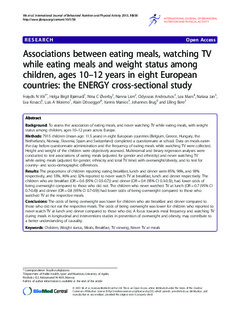| dc.contributor.author | Vik, Frøydis N. | |
| dc.contributor.author | Bjørnarå, Helga Birgit | |
| dc.contributor.author | Øverby, Nina Cecilie | |
| dc.contributor.author | Lien, Nanna | |
| dc.contributor.author | Androutsos, Odysseas | |
| dc.contributor.author | Mas, Lea | |
| dc.contributor.author | Jan, Nataša | |
| dc.contributor.author | Kovacs, Eva | |
| dc.contributor.author | Moreno, Luis A. | |
| dc.contributor.author | Dössegger, Alain | |
| dc.contributor.author | Manios, Yannis | |
| dc.contributor.author | Brug, Johannes | |
| dc.contributor.author | Bere, Elling | |
| dc.date.accessioned | 2013-07-17T13:01:54Z | |
| dc.date.available | 2013-07-17T13:01:54Z | |
| dc.date.issued | 2013 | |
| dc.identifier.citation | Vik, F.N., Bjornara, H.B., Overby, N.C., Lien, N., Androutsos, O., Maes, L., . . . Bere, E. (2013). Associations between eating meals, watching TV while eating meals and weight status among children, ages 10-12 years in eight European countries : the ENERGY cross-sectional study. International Journal of Behavioral Nutrition and Physical Activity, 10: 58. | no_NO |
| dc.identifier.uri | http://hdl.handle.net/11250/139055 | |
| dc.description.abstract | Background: To assess the association of eating meals, and never watching TV while eating meals, with weight status among children, ages 10-12 years across Europe.
Methods: 7915 children (mean age: 11.5 years) in eight European countries (Belgium, Greece, Hungary, the Netherlands, Norway, Slovenia, Spain and Switzerland) completed a questionnaire at school. Data on meals eaten the day before questionnaire administration and the frequency of eating meals while watching TV were collected. Height and weight of the children were objectively assessed. Multinomial and binary regression analyses were conducted to test associations of eating meals (adjusted for gender and ethnicity) and never watching TV while eating meals (adjusted for gender, ethnicity and total TV time) with overweight/obesity, and to test for country-and socio-demographic differences.
Results: The proportions of children reporting eating breakfast, lunch and dinner were 85%, 96%, and 93% respectively, and 55%, 46% and 32% reported to never watch TV at breakfast, lunch and dinner respectively. The children who ate breakfast (OR = 0.6 (95% CI 0.5-0.7)) and dinner (OR = 0.4 (95% CI 0.3-0.5)), had lower odds of being overweight compared to those who did not. The children who never watched TV at lunch (OR = 0.7 (95% CI 0.7-0.8)) and dinner (OR = 0.8 (95% CI 0.7-0.9)) had lower odds of being overweight compared to those who watched TV at the respective meals.
Conclusions: The odds of being overweight was lower for children who ate breakfast and dinner compared to those who did not eat the respective meals. The odds of being overweight was lower for children who reported to never watch TV at lunch and dinner compared to those who did. A focus towards meal frequency and watching TV during meals in longitudinal and interventions studies in prevention of overweight and obesity, may contribute to a better understanding of causality. | no_NO |
| dc.language.iso | eng | no_NO |
| dc.publisher | BioMed Central | no_NO |
| dc.rights | Navngivelse 4.0 Internasjonal | |
| dc.rights.uri | http://creativecommons.org/licenses/by/4.0/deed.no | |
| dc.title | Associations between eating meals, watching TV while eating meals and weight status among children, ages 10-12 years in eight European countries : the ENERGY cross-sectional study | no_NO |
| dc.type | Journal article | no_NO |
| dc.type | Peer reviewed | no_NO |
| dc.rights.holder | © 2013 The Author(s) | |
| dc.subject.nsi | VDP::Medical disciplines: 700::Health sciences: 800::Nutrition: 811 | no_NO |
| dc.source.pagenumber | 10 | no_NO |
| dc.source.volume | 10 | no_NO |
| dc.source.journal | International Journal of Behavioral Nutrition and Physical Activity | no_NO |
| dc.identifier.doi | https://doi.org/10.1186/1479-5868-10-58 | |
| dc.source.articlenumber | 58 | |

